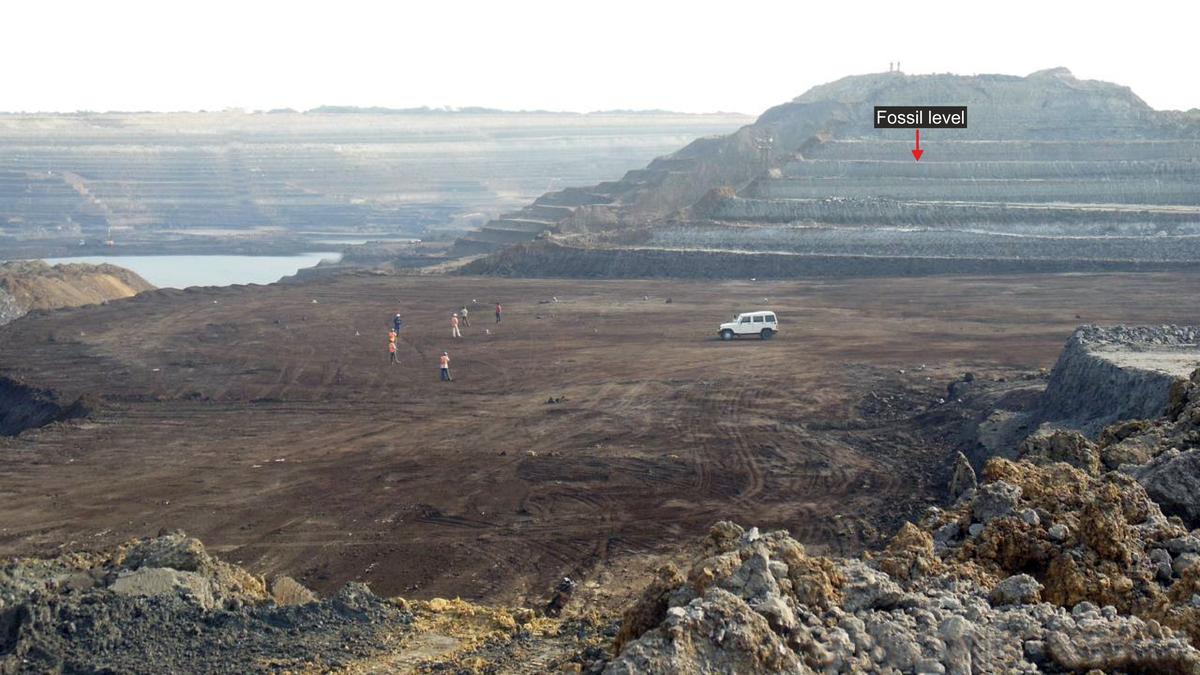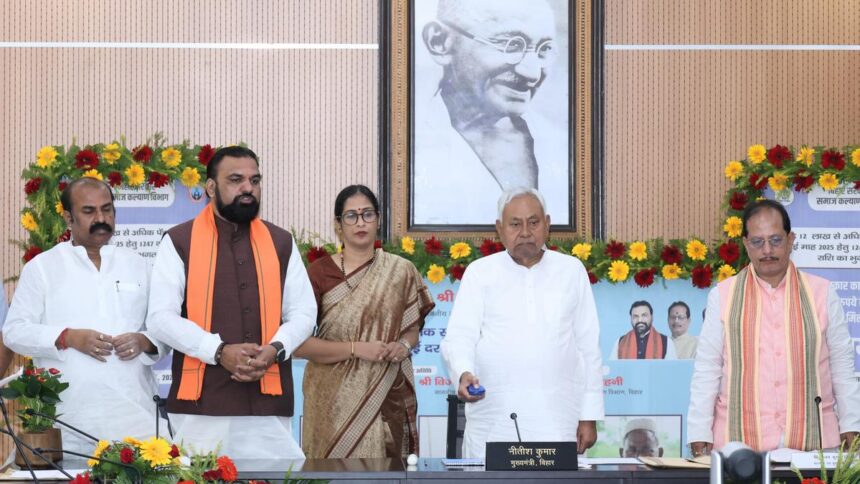In Western India, some of the country’s richest fossil beds lie inside open coal mines. It is gruelling work for palaeontologists with long days under a haze of dust, the deafening hammering of tools, and nights in small-town hotels with basic comforts.
In 2024, palaeontologist Sunil Bajpai reported that at one such dig, he and his team uncovered the fossilised vertebrae of Vasuki indicus. This ancient giant snake may have stretched as long as a tour bus. But without a national repository or a secure, catalogued fossil locker like those abroad, the stony remains of this 47-million-year-old serpent face an uncertain future.
“I worry about what will happen to these fossils after I retire in two years,” said 63-year-old Bajpai, chair professor of vertebrate palaeontology at IIT-Roorkee. “Will they be preserved or fall victim to theft or vandalism?”
Around the world, fossils once bound for labs are now advertised in storefronts and auction houses. Ammonites, extinct sea creatures with coiled shells, once crowded ancient oceans. Today, their fossilised remains are sold on the streets of Paris. Larger, rarer specimens fetch staggering sums at auctions from private collectors.

In July 2024, Sotheby’s auction house in New York sold a near-complete stegosaurus, a plant-eating dinosaur with spikes, for $44.6 million. It was the most expensive fossil ever auctioned. In California, luxury homes trumpet dinosaur skeletons as living-room showpieces.
Thomas Carr is a palaeontologist at the Carthage Institute of Palaeontology in Wisconsin in the U.S. He studies fossils of Tyrannosaurus rex, one of the largest meat-eating dinosaurs in history. In a study published this April titled ‘Tyrannosaurus rex: An Endangered Species’, Carr reported that 71 scientifically important T. rex specimens are in private hands. Just 61 of these finds are held by public institutions.
“Commercial collectors have gathered more T. rex material than scientists have since the first specimen was discovered,” Carr said over a phone call. “The rate of collection by commercial interests was the most surprising and the most alarming.”
Heritage at risk
Over decades, India’s cultural treasures have often vanished into private hands. In 1898, a British landowner unearthed hundreds of gems from a Buddhist shrine in Uttar Pradesh. The relics stayed in his family for generations before part of the collection was slated for auction at Sotheby’s in Hong Kong in 2025. The Indian government blocked the sale. Scientists caution that fossils could be the next heritage lost to the auction block.
“The palaeontological record of India, especially the Mesozoic age, is incredibly important to our understanding of the evolution of dinosaurs and other organisms,” Carr said, referring to the ‘age of reptiles’ when dinosaurs ruled the earth. “We can’t afford to lose it.”
India’s fossil record includes some of the earliest plant life, dinosaurs and even a skull of ancient humans. That wealth of fossils is due to the subcontinent’s prolonged isolation after splitting from the southern supercontinent Gondwanaland around 150 million years ago. After India collided with Asia 50 to 60 million years ago, ancestral horses and whales emerged along its coasts.
“As of now there are no laws governing fossils and there are huge concerns about vandalisation and local sales taking place,” Bajpai said. “If we don’t move fast, we’re going to lose a part of earth’s history that you can never get back. Once a fossil is gone, it’s gone forever.”

Unsung custodians
Fossils can vanish without trace: misplaced in storerooms, crumbling from heat and rain or hidden away in private collections. One large cache of Indian fossils today lies with the Ranga Rao-Obergfell Trust. It is a collection built by the late Indian palaeontologist M.S. Ranga Rao and his late wife, the German palaeontologist Friedlinde Obergfell.
The couple unearthed truckloads of fossils, including bones of a small, hoofed, land-dwelling herbivore called Indohyus. Dutch-American palaeontologist Hans Thewissen examined the specimen in 2005 and spotted features that signaled that Indohyus was one of the earliest known whale ancestors. The private collection is now kept in a Dehradun home. Some fossils even lie exposed in the garden, according to Bajpai. The collection, built over decades, remains largely unsorted and unstudied.
With no formal safeguards, some enthusiasts have turned custodians of India’s deep history. Vishal Verma, a schoolteacher in Madhya Pradesh, spends weekends rescuing dinosaur bones and shells from riverbeds. The limestone and basalt hills in his neighbourhood, formed 146-65 million years ago, cradle fossilised dinosaur nests and eggs. Ammonites coiled like snakes, slabs of fossil wood and shards of reptile teeth fill every corner of Verma’s home.
“We have to recognise the importance of these finds — they tell the story of our past, the story of earth,” said Verma, speaking in Hindi. “There must be strict measures against misuse and vandalism. Fossils should be accessible to people, but they must also be protected.”
In 2006, Verma stumbled upon hundreds of dinosaur eggs. He borrowed money to rent a truck and move some to a government museum in Mandav. But that wasn’t enough to protect them. In 2013, some of the eggs were stolen and the rest were locked away from public view.
“One day they were on the shelf and the other day they weren’t,” said Ashok Sahni, a veteran Indian palaeontologist of the theft. “Well, when money comes into the picture, it’s very difficult in a country like ours to safeguard anything because you can put guards and you can put wire and you can do everything. They did that at the Mandav museum and still, they lost some of the dinosaur eggs kept there and nobody knows how.”

Fossils for sale
Fossils aren’t just prey for vandals or roadside sellers anymore. A simple Google search can lead you to sites openly selling fossilised dinosaur eggs. They’ve also become trophies for the rich.
The stegosaurus fossil that sold for a record $44.6 million at Sotheby’s last year went to hedge fund trader Kenneth Griffin. The fossil frenzy has even drawn Hollywood celebrities like Nicolas Cage and Leonardo DiCaprio, who once had a bidding war over a dinosaur skull. Sotheby’s has further stoked the appetite, carving out a new department in 2021 selling fossils alongside space and cinema memorabilia.
A few years ago, a draft plan for a national fossil repository in India raised hopes. But that plan has barely progressed. Experts warn that in its absence, India’s prehistoric treasures remain vulnerable to auctions abroad.
“With no law to prohibit their extraction or sale, it’s entirely possible that dinosaur eggs from India have found their way into overseas markets,” Bajpai said.
For now, the 27 fossilised vertebrae Bajpai found of the Vasuki indicus rest in a box at IIT-Roorkee. At an estimated 49 feet, the giant python-like snake would have been longer than the T. rex that palaeontologist Carr found to be drifting into private hands. Only time will tell if this fossil will be safeguarded as a national treasure, safe from any auction block.
anupama.c@thehindu.co.in
Published – August 26, 2025 05:30 am IST






















